http://covertoperations.blogspot.com/2007/01/speed-calculations-for-immaculate.html
NIST say that the "Flight 11" wheel, which ended up at Recter and West, may have exited the building through an opening in the south side of the North Tower that was created by the dislodging of the external panel pictured below. This panel was found on Cedar Street, between 500 feet (1) and 1,000 feet (2) from the North Tower, and has wedged in it another wheel allegedly from "Flight 11." NIST say this in the 3 pages of their report reproduced below. (These panels of columns have also been referred to as "modules.")

NIST say that the impact of airplane debris propelled this external panel from the North Tower to this location, at least 500 feet. This panel is very heavy, perhaps six tonnes. (3) I could understand this panel being propelled to Cedar Street by the explosion of the North Tower, which videos show resulted in tremendous lateral forces. I cannot see the panel propelled hundreds of feet by the impact of aircraft debris that has passed through one wall of external columns, the core, and workstations on both sides of the core. Moreover, as shown below, "Flight 11" is said to have impacted at a downward angle, increasing the distance and the resistance that would have to overcome to get to the other side of the building. Even assuming that the external columns are weaker against force applied from the inside, there is simply no way that the columns were propelled hundreds of feet, and I doubt that they were dislodged by airplane debris at all.
For an idea of the size of these columns, here is a photograph of one of these external columns being installed.

 Outside the right side of Cedar Street in picture above is is the Saint Nicholas Greek Orthodox Church, which was destroyed on September 11 by the exploding buildings. At right is a view of the South Tower and North Tower from just in front of the church, which is a view from approximately where the panel is said to have landed on Cedar Street. The North Tower is at left.
Outside the right side of Cedar Street in picture above is is the Saint Nicholas Greek Orthodox Church, which was destroyed on September 11 by the exploding buildings. At right is a view of the South Tower and North Tower from just in front of the church, which is a view from approximately where the panel is said to have landed on Cedar Street. The North Tower is at left. Here is a view of the South Tower exploding from in front of Saint Nicholas. The church's board president stated:
Here is a view of the South Tower exploding from in front of Saint Nicholas. The church's board president stated:"That day was a nightmare. The debris from the south tower literally pancaked our church. You know, it was an unbelievable amount of debris on it." (4)
According to articles about this church and its destruction on 9/11, the front of the Church on Cedar Street is between 500 and 1,000 feet from "Ground Zero."(1),(2). I will assume 500 feet. The location of Saint Nicholas is indicated in the first photo, and the location of the church can be found to the right of the bridge across West Street in the second and third photos. As one can see, the distance is considerable.



Update: Courtesy of Spooked, here is another photo of the panel and wheel which gives a better perspective on the panel's size, and shows Saint Nicholas Church with the South Tower in the background. This photo also tells me that I was right not to use the 1,000 feet figure from the article in endnote 2, because I cannot see how the church's parking lot on Liberty Street is 750 feet from the church's front door on Cedar Street. Based on the aerial maps and photos above, I estimate that the south face of the North Tower is roughly 300 feet from the south face of the South Tower seen in the background of this photo. I agree with Spooked's comment below that the actual distance is 600 feet, but will continue continue to use my conservative estimate of 500 feet.
Spooked wrote about this panel and wheel last year, and I concur that they are truly bizarre:
http://covertoperations.blogspot.com/2006/05/truly-bizarre.html
Spooked raises more doubts here:
http://covertoperations.blogspot.com/2007/01/things-like-this-disturb-my-sleep.html
The fact that the panel is next to the intact church tells me that it has been planted there, because the church was completely destroyed by the collapse of the South Tower. As I have said, the only plausible argument that this panel is authentic is that it was propelled here by the explosion (the so-called "collapse") of the North Tower, but this has not yet occurred in this picture.


Remember from my first "little wheel" article that none of the NIST models showed any landing gear getting through the core of the building. Update: as explained in an update to that article, I think I misread NIST - rather the models showed the landing gear stopping in the core or just outside the core on the opposite side. So even in the most severe impact scenario, landing gear barely made it through the core. The point remains that little kinetic energy would have remained to impact the external columns on the south side. Figure 7-68 to the right in the NIST report shows the very columns pictured on Cedar Street below, and shows the damage caused to these columns in NIST's most severe scenario.
NIST say that the calculated damage was "substantial," and say that "based on the failure modes observed on the north face and the speed and mass of the debris, the panel would potentially be knocked free by the failing at the connections."
NIST state on the above two pages: "As little other damage had been documented on the south face of WTC 1, it is postulated that the landing gear that landed at the corner of Recter St. and West St. also exited through this panel location."
Even if this panel could be "knocked free," that is a completely different matter from being propelled 500 feet, yet that is what NIST say happened, based on the column panel pictured on Cedar Street which they are stating arrived there as the result of aircraft debris. NIST do not argue that the engines pierced the core and exited the south face of WTC1, but even the massive engines could not do this.

These columns must have been deposited here by the explosions, not an airplane impact, and therefore the wheel on Recter and West, even if it had gotten through the core, would not have breached the external columns on the south side of the North Tower.

This page just shows that the panel on Cedar Street, Figure 7-70, is what is being discussed in the two pages above.
I suppose it is a possible, though very unlikely, that this wheel made it through the core and was embedded in these columns, and then the columns were propelled here by the explosion of the North Tower. Again, NIST's models showed that no landing gear would have made it through the core.
I should also mention the possibility that the panel was knocked off by the plane impact, falling to the ground and opening a space for the Recter/West wheel, and then was propelled to Cedar Street by the explosion of the North Tower. This seem very unlikely, if not impossible, especially since the panel would have been buried by the debris of the South Tower. Could the panel have been propelled part way by the South Tower explosion and the rest of the way by the North Tower? Only in a NIST report.
My main point here is refuting NIST's speculation that these columns were knocked off by airplane debris, opening a door for the wheel at Recter and West to fly out of the North Tower at 105 mph. The columns pictured on Cedar Street were not knocked off, because they would not be there if they had been.
Below are two photographs of the south face of the North Tower prior to its annihilation. The first, taken at 9:41:30 a.m, shows what could be a missing panel at floors 93-96, columns 329-331. However, the second, taken at 10:23 a.m., does not show this missing panel. Columns 329-321 are approximately in the middle of the south face shown in the second picture, so the black line jutting down in the second picture is not columns 329-331. [Update: Thanks to a comment by Spooked below, I realize I mistook the west face for the south face in the second photo, Figure 6-14, below. Pending further analysis, which is difficult because the south face is obscured by smoke in Figure 6-14, I conclude that the pictures are consistent. This does not change my conclusion, as there is no way the panel was propelled 500 feet or more. The only way that panel could have arrived on Cedar Street prior to the explosion of the North Tower is that it was carried there.]

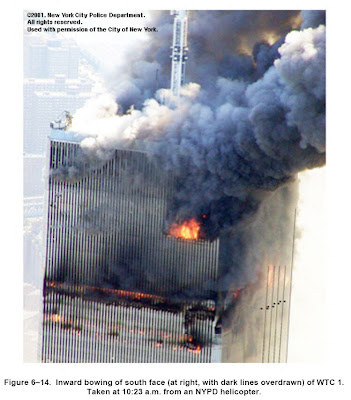
Even if a panel were missing, it had not been propelled 500 feet at the time of the picture. If the panel on Cedar Street is missing in the above pictures that were taken prior to the explosion of the North Tower, then the panel had to be planted at Cedar Street, because only the explosion could have conceivably propelled it there.
Even if debris made it through the core and hit the interior surface of the south face of the North Tower, it would have been moving slowly. The massive starboard engine of "Flight 175" in the South Tower, which did not pass through the core, could not have done this. NIST's most severe impact model showed that engine decelerating from 575 mph to less than 100 mph, as a result only of the external panel and floor truss and workstations. It is doubtful the engine moving at this speed could even dislodge the columns, though I could be wrong. It is absurd to think that the engine could have dislodged the columns and propelled them 500 feet.
Here is the trajectory of the WTC2 starboard engine, not through the core :

Here is the speed of the WTC2 starboard engine, ending at 0.6 seconds:

All the debris of "Flight 11" would pass directly through the massive core, unlike "Flight 175," and with lower initial velocity:

Moreover, "Flight 11" impacted at a steeper angle, resulting in more interaction with the floors and a longer path through the building (as well as a debris trajectory further from the horizontal trajectory assumed by NIST in getting the wheel to Recter and West. ) "The vertical component of the impact load in WTC1 was approximately 40 percent higher than in WTC2."
 Based on all of the above, I do not believe that the impact of a plane propelled a wheel to Recter and West. I also question the authenticity of the wheel embedded in a massive steel panel on Cedar Street, which could only have gotten there by passing through the core, wedging itself in the steel columns, and being propelled to Cedar Street. It is more likely the wheel was planted in the steel columns prior to the alleged impact of "Flight 11," and propelled to Cedar Street by the explosion of the North Tower. I am assuming the explosion could do that, but do not know.
Based on all of the above, I do not believe that the impact of a plane propelled a wheel to Recter and West. I also question the authenticity of the wheel embedded in a massive steel panel on Cedar Street, which could only have gotten there by passing through the core, wedging itself in the steel columns, and being propelled to Cedar Street. It is more likely the wheel was planted in the steel columns prior to the alleged impact of "Flight 11," and propelled to Cedar Street by the explosion of the North Tower. I am assuming the explosion could do that, but do not know.As in their discussion of the "collapses," NIST appear to be straining in any way they can to reconcile photographs that do not match their calculated models.
Endnotes:
(1) The distance of 500 feet from Saint Nicholas to Ground Zero is from here:
http://www.pravoslavie.ru/english/news010914.htm
ST. NICHOLAS CHURCH DESTROYED IN TWIN TOWERS ATTACK New York, September 14, 2001
The terrorist attack against the Twin Towers of the World Trade Center that killed an estimated 5,000 people Greek Orthodox Church, also destroyed tiny St. Nicholas located about 500 feet from ground zero.
(2) The distance of 1,000 feet from Cedar Street to Ground Zero is here:
http://www.greekworks.com/content/index.php/weblog/extended/saint_nicholas_the_lost_chapel_of_the_financial_district/
Thursday, November 15, 2001
"Saint Nicholas: The Lost Chapel of the Financial District"
When the World Trade Center towers fell on September 11, Saint Nicholas Greek Orthodox Church was totally buried by the debris.These relative distances don't seem to match the map, and it is unclear in both articles whether Ground Zero is the center of the complex or the closer South Tower, or some other point. Therefore, I chose the lower figure of 500 feet, though I think the actual distance may have been higher.
The building rose to a height of only 35 feet.
Depending on how one reckons the distance between the church building (the front door of which was on Cedar Street) and the asphalt parking lot behind it (that ran north to Liberty Street), Saint Nicholas was either within 250 feet of Ground Zero or some 1,000 feet.
(3) The estimated panel weight is from here:
http://guardian.150m.com/wtc/godfrey.htm
The external framework was erected using prefabricated three-storey units, each comprising columns interconnected by spandrel panels. These units, ranging in weight from 22.3 to 6.0 tonnes, were fitted together, alternately staggered in one storey heights, and spliced with high-strength friction-grip bolts."
(4) From the transcript of a short film about the history of Saint Nicholas Greek Orthodox Church and what happened to it on 9/11, available here:
http://www.pbs.org/wnet/religionandethics/week902/feature.html
There are no views of the church after it was destroyed and it is more a human interest story, but I want to show respect for the church and its parishioners, who are victims of the 9/11 crimes that I had been unaware of, and who should get restitution for their loss when the perpetrators are tried and convicted.

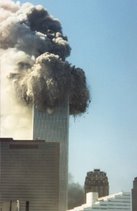

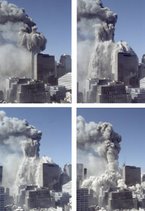

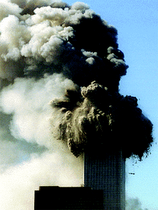

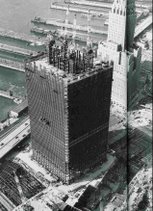
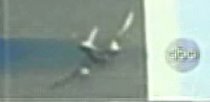
9 comments:
That tire in the columns has got to be some kind of sick joke. I saw that item in the NIST report some time back and still can't get over how absurd it is.
And this is before I even saw from your post how damn far away that set of columns was. There is no way in the world those columns flew so far from the tower. They are just too big and heavy. I don't even know how they could have been propelled even if much of the plane hit them smack dab from the other side. But if they came from that SE corner? NO WAY, since there could be no direct hit from anything that entered on the center of the north face.
The map here looks like it is at least 600 feet from Tower 1 to Cedar street:
http://www.google.com/maps?client=firefox-a&rls=org.mozilla:en-US:official&ie=UTF-8&oe=UTF-8&hl=en&channel=s&tab=wl&q=
The only possibilities are:
1) the columns fell much closer to WTC1, and were moved to cedar street as the wheel was planted.
2) POWERFUL explosives were planted directly behind the set of columns to blow them out and then the wheel was planted afterwards. The problem with the second case is the columns should have been more damaged by the explosives. So I think the former (1) is the case.
It seems possible if the columns fell in Liberty street that people were instructed to move them out of the way of rescue vehicles and the columns were quickly picked up and dumped on Cedar street.
Lastly, in figure 6-14-- is the south face the large front face or the smoke-distorted face to the right? (That bowing explanation is bunk, btw. That's worse than anything even a lame conspiracy theorist would come up with).
there's also the matter of the fact that if those columns had really fallen THAT far DOWN, they would have chewed up the street quite a bit more.
This pic from my blog gives a different view of the columns that allows a better assessment of where they were:
http://photos1.blogger.com/blogger/5459/522/1600/wheel%20in%20broken%20steel%20columns.jpg
I guess another possibility is that the columns were a mock up of WTC columns that were standing by waiting to be used on 9/11.
Thanks, Spooked, you're right -- I mistook the west face for the south face of the North Tower in Figure 6-14. It's hard to draw any conclusions from that picture because smoke obscures where Columns 29-31 would be. It does look like there is a blackened area beneath the smoke in the approximate location of the panel that was knocked off.
I agree that if the panel is indeed missing in the south face photos taken prior to the explosion of the North Tower, then the panel must have been carried to Cedar Street.
I've heard that some massive materials were blown over 500 feet by the explosions of the towers, and it's possible the side of the Cedar Street that suffered most damage is face down. It seems the wheel in that case would also be on the face down side. I think you're right that if it was propelled there by explosion, the wheel was likely planted.
Even if a door had been opened by this panel, which I think I have ruled out, the wheel found further away at Recter and West would not have left the North Tower at 105 mph. It is doubtful it coud have gotten through the core at all.
Thanks for the comments and catching my mistake, Spooked.
Assuming that the panel is missing in the photos and was knocked off, I concur with Spooked that the panel was moved to Cedar Street, possibly for a legitimate reason like clearing rescue routes on Liberty Street, and that the wheel was planted in the Cedar Street panel. I think that the other wheel could not have it through the core, as shown by NIST's models and my own common sense.
Even if wheel found at Recter and West did make it through the core, the wheel could not be propelled to Recter and West even if the resistance of this panel were removed. Therefore, the possibility of the panel being knocked off does not change my conclusion about the Recter and West wheel.
The main point of Part 2 was to address the possibility left open by NIST that the Recter and West wheel flew through a door opened by this dislodged panel. My conclusion is that I have disproved this theory by showing that even if the wheel exited at the point of this dislodged panel, it would not have had the residual velocity to fly to Recter and West. Further, I have shown that the Cedar Street wheel was planted in the panel, and the panel it was wedged in may also have been planted on Cedar Street.
Spooked said: "there's also the matter of the fact that if those columns had really fallen THAT far DOWN, they would have chewed up the street quite a bit more."
One would think so. One possibility is that the panel landed in such a way as to slide down the little inclined street between Liberty and Cedar and came to rest there. It seems the panel would sink into soft asphalt and not move, and even if the panel landed some tens of feet closer to the North Tower and came to rest there, my conclusion doesn't change.
This is great stuff, Ningen. Keep up the good work!
Fred
Consider this:
1. To dislodge this panel 12 separate connection points had to be defeated simultaneously, otherwise the panel would hinge where there most resistance.
2. To dislodge the force would have had to be extraordinary because the windows would blow out first, thereby reducing the surface area that could accept the pushing forces.
3. What are the chances the wheel arrived at the window opening upright and centered on a window opening?
4. What are the chances of the wheel making it through the core area intact to then wedge itself perfectly in the opening and then stay lodged when the panel struck the ground?
5. What are the chances that this massive panel falls to the ground at 8:46am, on a workday, in downtown Manhattan, without killing anyone or damaging any vehicles?
This is too unbelievable. Add this to the hundred other anomalies we have found from 9/11.
The 9/11 tragedy gives the biggest impact for the people all over the world. A lot of people give sympathy on that matter.
Post a Comment